In-Depth Analysis of Teams, Motivation, and CVF in Management Context
VerifiedAdded on 2023/06/18
|13
|2721
|303
Report
AI Summary
This report provides an in-depth analysis of teamwork, motivation theories, and the Competing Values Framework (CVF) within a management context. It begins by demonstrating an understanding of teams and motivation theories, including Maslow's hierarchy of needs and Herzberg's two-factor theory, applying these concepts to a group project involving historical research and presentation development. The report further showcases the ability to apply the CVF model to personal actions and behaviors, emphasizing collaboration, creation, control, and competition. The analysis integrates personal experiences and reflections, highlighting the importance of motivation and effective team dynamics in achieving goals. The document concludes that teamwork is effective due to motivational theories and CVF criteria, and that content and process theories play a vital role.

Fundamentals of
management
management
Paraphrase This Document
Need a fresh take? Get an instant paraphrase of this document with our AI Paraphraser
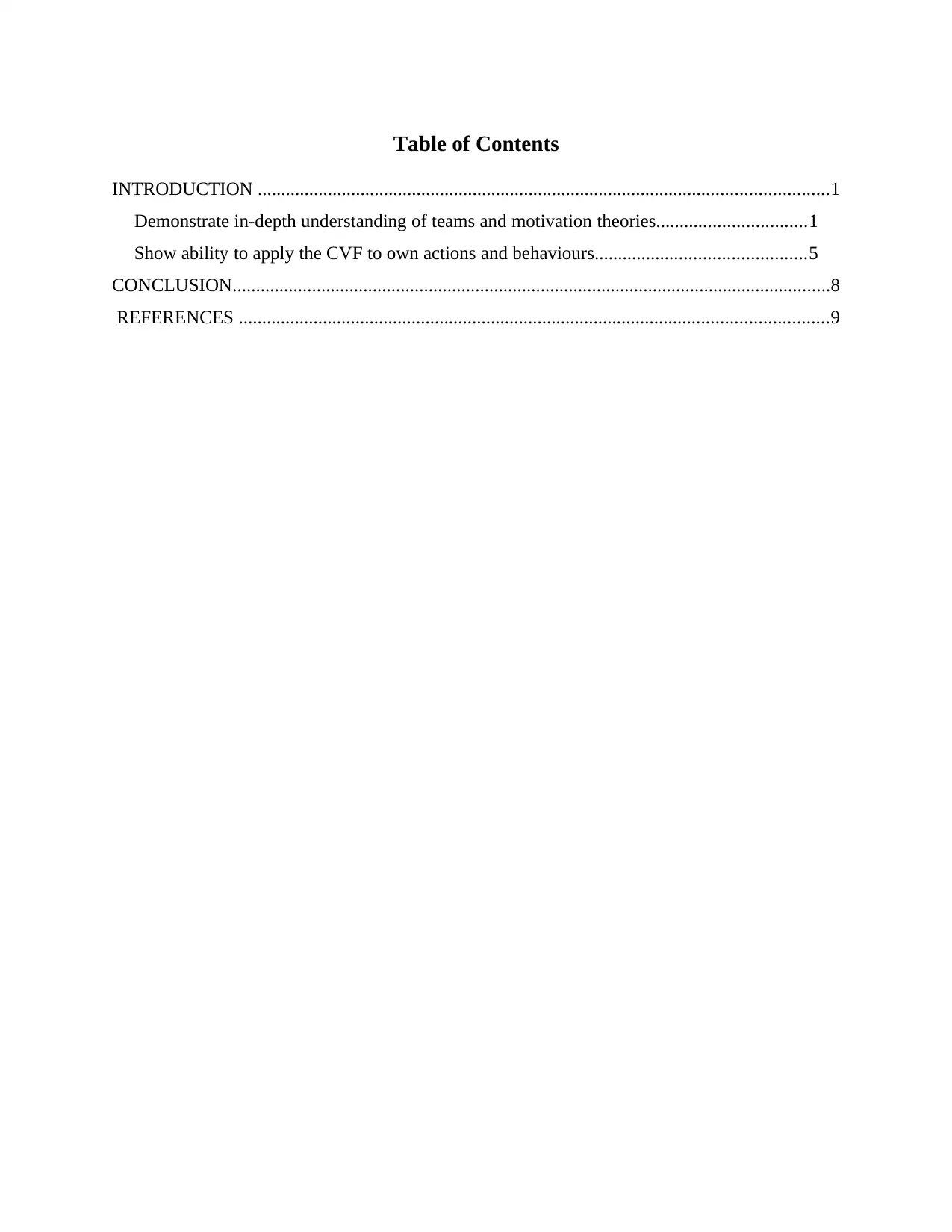
Table of Contents
INTRODUCTION ..........................................................................................................................1
Demonstrate in-depth understanding of teams and motivation theories................................1
Show ability to apply the CVF to own actions and behaviours.............................................5
CONCLUSION................................................................................................................................8
REFERENCES ..............................................................................................................................9
INTRODUCTION ..........................................................................................................................1
Demonstrate in-depth understanding of teams and motivation theories................................1
Show ability to apply the CVF to own actions and behaviours.............................................5
CONCLUSION................................................................................................................................8
REFERENCES ..............................................................................................................................9

INTRODUCTION
In the academic and professional life individual have to work on various task and
activities in context to the skills and knowledge development (Davis, 2019). In order to
complete all task easing to the group, every members have to effectively apply team work and
motivation, skills or theory's. There are the various important models and tools which aid to
accomplish the effective team work. This report is involving the brief evaluation of earlier team
work project of week 21 in context to the analysis of team performance and actions, that how
were the motivation and CVF model used or helpful in that task.
Demonstrate in-depth understanding of teams and motivation theories
In the week 21 group task of historical personality online research and PPT development
or presentation, I worked with three more partners and proceed with the critical analysis,
research and learning to produce effective PPT report. But in context to the effective
achievement that is very important be motivate along with team, as it aid to make good results
with relevant information (Du and Jackson, 2018). For the project we go through the online
site of the Museum of London and then selected Queen Elizabeth ll for the further research and
work accomplishment. At the each step we faced and managed the motivational needs and
issues. Below is the brief illustration or explanation of our team work in context to the different
stages of goal accomplishment and motivation.
1
In the academic and professional life individual have to work on various task and
activities in context to the skills and knowledge development (Davis, 2019). In order to
complete all task easing to the group, every members have to effectively apply team work and
motivation, skills or theory's. There are the various important models and tools which aid to
accomplish the effective team work. This report is involving the brief evaluation of earlier team
work project of week 21 in context to the analysis of team performance and actions, that how
were the motivation and CVF model used or helpful in that task.
Demonstrate in-depth understanding of teams and motivation theories
In the week 21 group task of historical personality online research and PPT development
or presentation, I worked with three more partners and proceed with the critical analysis,
research and learning to produce effective PPT report. But in context to the effective
achievement that is very important be motivate along with team, as it aid to make good results
with relevant information (Du and Jackson, 2018). For the project we go through the online
site of the Museum of London and then selected Queen Elizabeth ll for the further research and
work accomplishment. At the each step we faced and managed the motivational needs and
issues. Below is the brief illustration or explanation of our team work in context to the different
stages of goal accomplishment and motivation.
1
⊘ This is a preview!⊘
Do you want full access?
Subscribe today to unlock all pages.

Trusted by 1+ million students worldwide

Content motivation theory
There are the different types of the content theory, which basically focus on the system of
need, because according to this concept people get motivated through the need of life. In my
group task of the Museum of London our important source of motivation and task
accomplishment were need of good results, marks, self value development, self actualization
needs.
Maslow's theory –
This is the motivational theory was given by the Maslow's, this illustrates the hierarchy of
the needs. According to this theory there are the five important stages of the needs which effects
the individuals behaviour and motivate them work hard and smart work in there personal and
professional life. The five stage of needs are Physiological needs, safety needs, love and
belonging needs, esteem needs and self actualization needs.
Physiological needs- This is the first stage of the needs in context to satisfaction of
which individual start working, that is involving the basic needs of food, water, shelter, clothings
etc. in context to us the most important influencing physiological need were autonomy,
relatedness and competence, by the influence of which we started working on the research
project (Koshkin, and et. al. 2018).
Safety needs- This is the second stage of the needs according to which, if once the
individuals physiological needs get satisfied then they move to work for the satisfaction of safety
needs such as freedom, health security, safe environment. In context to the student the important
safety needs are environment, physical, psychological, transportation, background verification
needs. We got motivated for the task accomplishment due to the influence of our background
verification and university safety facility achievement needs (Oeldorf-Hirsch, 2018).
Love and belonging needs- This is the third stage of the individuals needs according to
which person get influence to work effective in order to get success in the satisfaction of their
belonging needs. Which involves friendship, trust, affiliating, connectedness, affection and love.
In context to the accomplishment of Queen Elizabeth ll research and ppt project, the main
influencer of our effective group performance was need of teachers trust, affection and love
satisfaction (Prochaska and Norcross, 2018).
2
There are the different types of the content theory, which basically focus on the system of
need, because according to this concept people get motivated through the need of life. In my
group task of the Museum of London our important source of motivation and task
accomplishment were need of good results, marks, self value development, self actualization
needs.
Maslow's theory –
This is the motivational theory was given by the Maslow's, this illustrates the hierarchy of
the needs. According to this theory there are the five important stages of the needs which effects
the individuals behaviour and motivate them work hard and smart work in there personal and
professional life. The five stage of needs are Physiological needs, safety needs, love and
belonging needs, esteem needs and self actualization needs.
Physiological needs- This is the first stage of the needs in context to satisfaction of
which individual start working, that is involving the basic needs of food, water, shelter, clothings
etc. in context to us the most important influencing physiological need were autonomy,
relatedness and competence, by the influence of which we started working on the research
project (Koshkin, and et. al. 2018).
Safety needs- This is the second stage of the needs according to which, if once the
individuals physiological needs get satisfied then they move to work for the satisfaction of safety
needs such as freedom, health security, safe environment. In context to the student the important
safety needs are environment, physical, psychological, transportation, background verification
needs. We got motivated for the task accomplishment due to the influence of our background
verification and university safety facility achievement needs (Oeldorf-Hirsch, 2018).
Love and belonging needs- This is the third stage of the individuals needs according to
which person get influence to work effective in order to get success in the satisfaction of their
belonging needs. Which involves friendship, trust, affiliating, connectedness, affection and love.
In context to the accomplishment of Queen Elizabeth ll research and ppt project, the main
influencer of our effective group performance was need of teachers trust, affection and love
satisfaction (Prochaska and Norcross, 2018).
2
Paraphrase This Document
Need a fresh take? Get an instant paraphrase of this document with our AI Paraphraser

Esteem needs- This is the fourth stage of the needs which influence for the hard work,
this involves the self esteem needs like confidence, strengths, self belief, personal and social
acceptance. In the group task we got motivated to complete that effectively, in context to the
satisfaction of personal and social value development, confidence and self belief. Because the
project was given to us was the grate opportunity of meeting the esteem needs (Rhodes and
et. al. 2021).
Self actualization needs- This is the fifth highest level of the needs, according to which
some individual with the strong esteem get motivated for the hard and smart work through the
influence of self actualization needs. In context to me and my team the self actualization at
university is achievement of the best position and value in the organisation along with
satisfaction of all level of the needs. The Museum of London research project was effectively
accomplished by me and my team through the influence of self actualization satisfaction need.
Herzberg's two factor theory – This is another important motivation theory which helps in the
motivation of individual. By helping in the understanding and application of two factor of
motivation. According to this theory there are the two factors at performance place which
influence the individual efforts. Such as motivation and hygiene factors, below is the brief
evaluation of these two factors in context to our team work accomplishment.
Motivation factors - There are the various motivators presence of which can the
individual to work hard, such as achievements, recognition, responsibilities, growth and
advancement. In my group research and presentation project we were motivated to effectively
accomplish all its task and activities due to the influence of university motivating factors such as
achievement of best position in class, recognition opportunity with best title and growth
opportunities. In order to get the best position and ranking in the class along with the aim of
getting recognise in university as good student and to garb various growth opportunities we work
hard to accomplish the project (Richardson, and Watt, 2018).
Hygiene factor- In the personal and professional work place there are the various
hygiene factors, absence of which can cause individuals to reduce their interest and work less
hard. University polices, supervision, relationship, education environment or condition,
remuneration, security. The university effective supervision, growth polices, positive
relationship and education environment was another hard work influencer, with the support and
influence of which we given our best for the accomplishment of research project.
3
this involves the self esteem needs like confidence, strengths, self belief, personal and social
acceptance. In the group task we got motivated to complete that effectively, in context to the
satisfaction of personal and social value development, confidence and self belief. Because the
project was given to us was the grate opportunity of meeting the esteem needs (Rhodes and
et. al. 2021).
Self actualization needs- This is the fifth highest level of the needs, according to which
some individual with the strong esteem get motivated for the hard and smart work through the
influence of self actualization needs. In context to me and my team the self actualization at
university is achievement of the best position and value in the organisation along with
satisfaction of all level of the needs. The Museum of London research project was effectively
accomplished by me and my team through the influence of self actualization satisfaction need.
Herzberg's two factor theory – This is another important motivation theory which helps in the
motivation of individual. By helping in the understanding and application of two factor of
motivation. According to this theory there are the two factors at performance place which
influence the individual efforts. Such as motivation and hygiene factors, below is the brief
evaluation of these two factors in context to our team work accomplishment.
Motivation factors - There are the various motivators presence of which can the
individual to work hard, such as achievements, recognition, responsibilities, growth and
advancement. In my group research and presentation project we were motivated to effectively
accomplish all its task and activities due to the influence of university motivating factors such as
achievement of best position in class, recognition opportunity with best title and growth
opportunities. In order to get the best position and ranking in the class along with the aim of
getting recognise in university as good student and to garb various growth opportunities we work
hard to accomplish the project (Richardson, and Watt, 2018).
Hygiene factor- In the personal and professional work place there are the various
hygiene factors, absence of which can cause individuals to reduce their interest and work less
hard. University polices, supervision, relationship, education environment or condition,
remuneration, security. The university effective supervision, growth polices, positive
relationship and education environment was another hard work influencer, with the support and
influence of which we given our best for the accomplishment of research project.
3
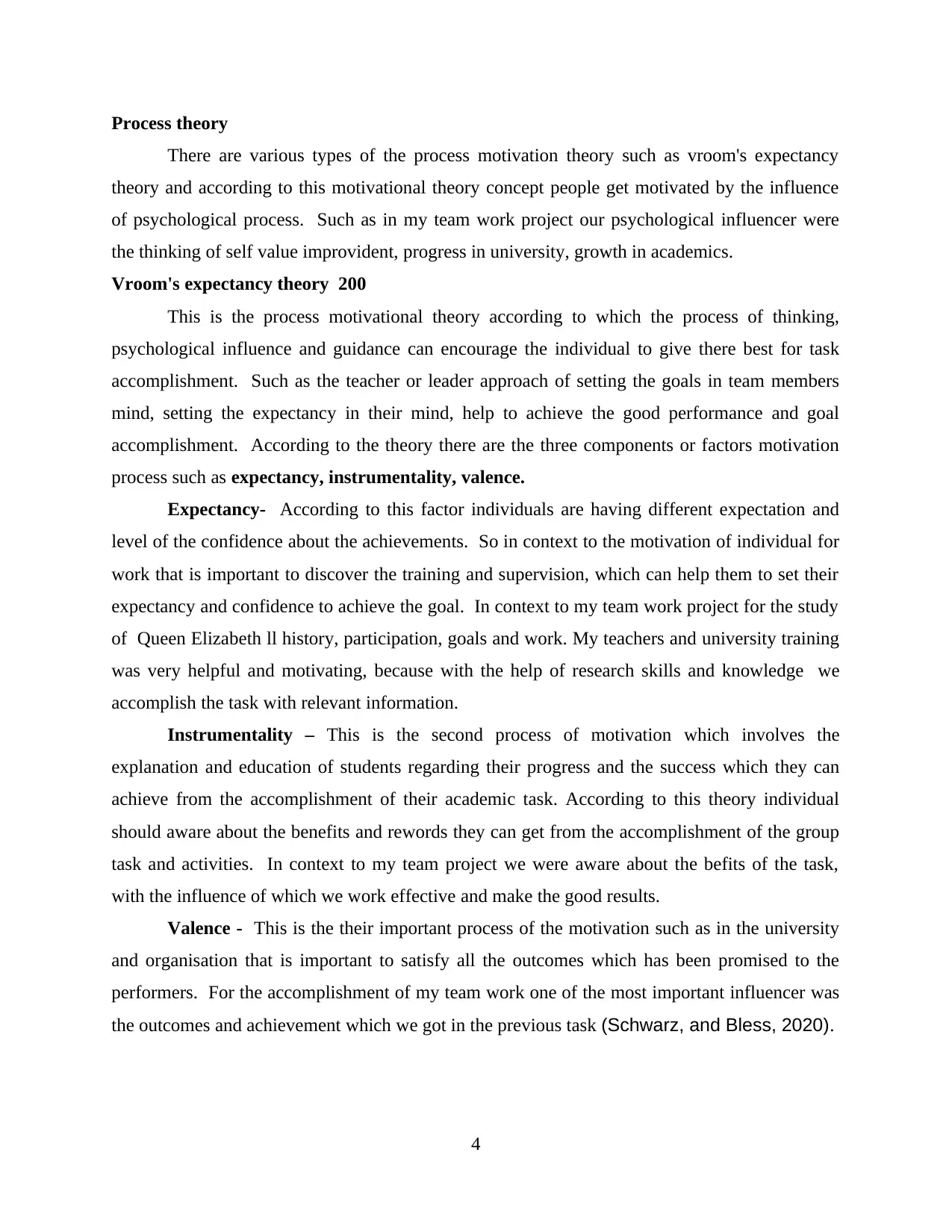
Process theory
There are various types of the process motivation theory such as vroom's expectancy
theory and according to this motivational theory concept people get motivated by the influence
of psychological process. Such as in my team work project our psychological influencer were
the thinking of self value improvident, progress in university, growth in academics.
Vroom's expectancy theory 200
This is the process motivational theory according to which the process of thinking,
psychological influence and guidance can encourage the individual to give there best for task
accomplishment. Such as the teacher or leader approach of setting the goals in team members
mind, setting the expectancy in their mind, help to achieve the good performance and goal
accomplishment. According to the theory there are the three components or factors motivation
process such as expectancy, instrumentality, valence.
Expectancy- According to this factor individuals are having different expectation and
level of the confidence about the achievements. So in context to the motivation of individual for
work that is important to discover the training and supervision, which can help them to set their
expectancy and confidence to achieve the goal. In context to my team work project for the study
of Queen Elizabeth ll history, participation, goals and work. My teachers and university training
was very helpful and motivating, because with the help of research skills and knowledge we
accomplish the task with relevant information.
Instrumentality – This is the second process of motivation which involves the
explanation and education of students regarding their progress and the success which they can
achieve from the accomplishment of their academic task. According to this theory individual
should aware about the benefits and rewords they can get from the accomplishment of the group
task and activities. In context to my team project we were aware about the befits of the task,
with the influence of which we work effective and make the good results.
Valence - This is the their important process of the motivation such as in the university
and organisation that is important to satisfy all the outcomes which has been promised to the
performers. For the accomplishment of my team work one of the most important influencer was
the outcomes and achievement which we got in the previous task (Schwarz, and Bless, 2020).
4
There are various types of the process motivation theory such as vroom's expectancy
theory and according to this motivational theory concept people get motivated by the influence
of psychological process. Such as in my team work project our psychological influencer were
the thinking of self value improvident, progress in university, growth in academics.
Vroom's expectancy theory 200
This is the process motivational theory according to which the process of thinking,
psychological influence and guidance can encourage the individual to give there best for task
accomplishment. Such as the teacher or leader approach of setting the goals in team members
mind, setting the expectancy in their mind, help to achieve the good performance and goal
accomplishment. According to the theory there are the three components or factors motivation
process such as expectancy, instrumentality, valence.
Expectancy- According to this factor individuals are having different expectation and
level of the confidence about the achievements. So in context to the motivation of individual for
work that is important to discover the training and supervision, which can help them to set their
expectancy and confidence to achieve the goal. In context to my team work project for the study
of Queen Elizabeth ll history, participation, goals and work. My teachers and university training
was very helpful and motivating, because with the help of research skills and knowledge we
accomplish the task with relevant information.
Instrumentality – This is the second process of motivation which involves the
explanation and education of students regarding their progress and the success which they can
achieve from the accomplishment of their academic task. According to this theory individual
should aware about the benefits and rewords they can get from the accomplishment of the group
task and activities. In context to my team project we were aware about the befits of the task,
with the influence of which we work effective and make the good results.
Valence - This is the their important process of the motivation such as in the university
and organisation that is important to satisfy all the outcomes which has been promised to the
performers. For the accomplishment of my team work one of the most important influencer was
the outcomes and achievement which we got in the previous task (Schwarz, and Bless, 2020).
4
⊘ This is a preview!⊘
Do you want full access?
Subscribe today to unlock all pages.

Trusted by 1+ million students worldwide
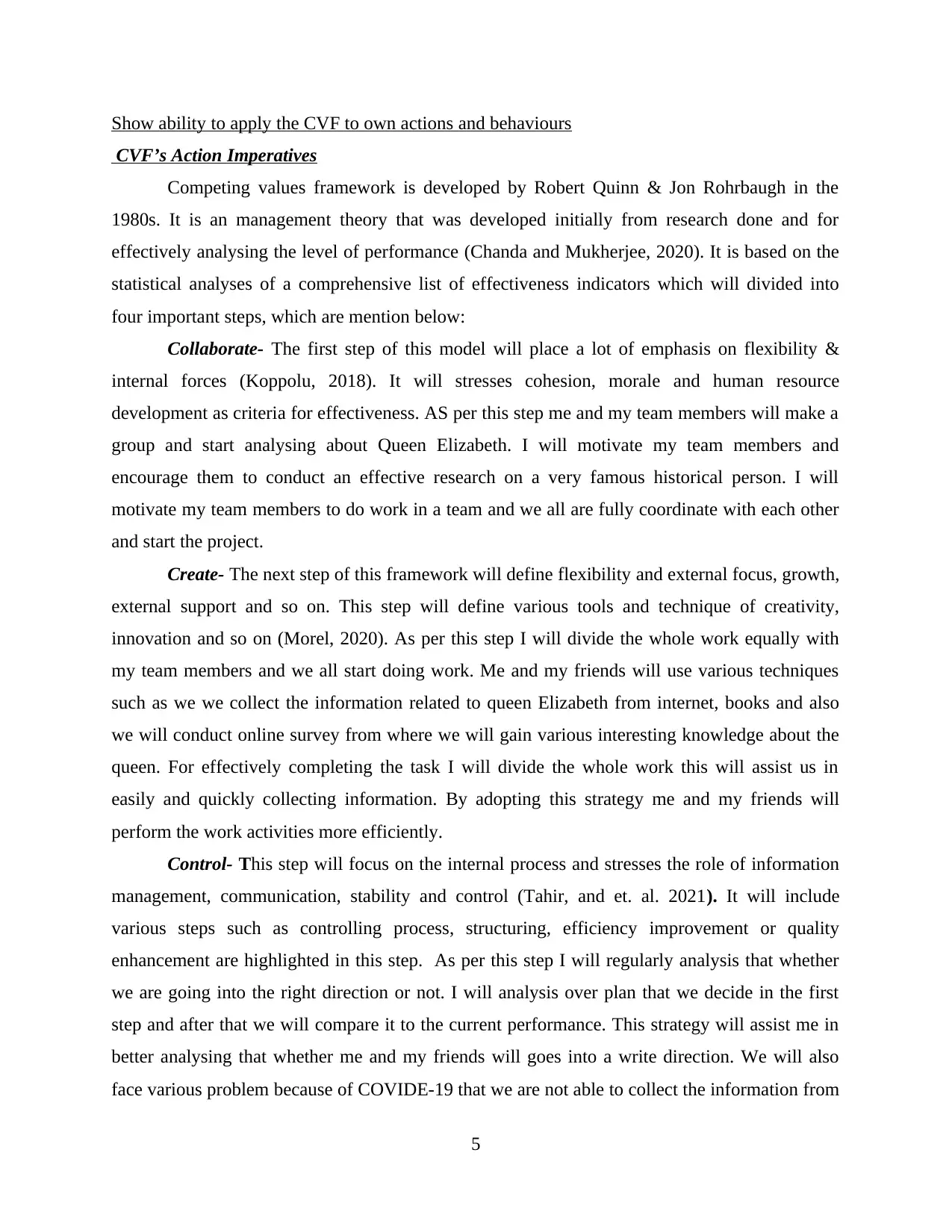
Show ability to apply the CVF to own actions and behaviours
CVF’s Action Imperatives
Competing values framework is developed by Robert Quinn & Jon Rohrbaugh in the
1980s. It is an management theory that was developed initially from research done and for
effectively analysing the level of performance (Chanda and Mukherjee, 2020). It is based on the
statistical analyses of a comprehensive list of effectiveness indicators which will divided into
four important steps, which are mention below:
Collaborate- The first step of this model will place a lot of emphasis on flexibility &
internal forces (Koppolu, 2018). It will stresses cohesion, morale and human resource
development as criteria for effectiveness. AS per this step me and my team members will make a
group and start analysing about Queen Elizabeth. I will motivate my team members and
encourage them to conduct an effective research on a very famous historical person. I will
motivate my team members to do work in a team and we all are fully coordinate with each other
and start the project.
Create- The next step of this framework will define flexibility and external focus, growth,
external support and so on. This step will define various tools and technique of creativity,
innovation and so on (Morel, 2020). As per this step I will divide the whole work equally with
my team members and we all start doing work. Me and my friends will use various techniques
such as we we collect the information related to queen Elizabeth from internet, books and also
we will conduct online survey from where we will gain various interesting knowledge about the
queen. For effectively completing the task I will divide the whole work this will assist us in
easily and quickly collecting information. By adopting this strategy me and my friends will
perform the work activities more efficiently.
Control- This step will focus on the internal process and stresses the role of information
management, communication, stability and control (Tahir, and et. al. 2021). It will include
various steps such as controlling process, structuring, efficiency improvement or quality
enhancement are highlighted in this step. As per this step I will regularly analysis that whether
we are going into the right direction or not. I will analysis over plan that we decide in the first
step and after that we will compare it to the current performance. This strategy will assist me in
better analysing that whether me and my friends will goes into a write direction. We will also
face various problem because of COVIDE-19 that we are not able to collect the information from
5
CVF’s Action Imperatives
Competing values framework is developed by Robert Quinn & Jon Rohrbaugh in the
1980s. It is an management theory that was developed initially from research done and for
effectively analysing the level of performance (Chanda and Mukherjee, 2020). It is based on the
statistical analyses of a comprehensive list of effectiveness indicators which will divided into
four important steps, which are mention below:
Collaborate- The first step of this model will place a lot of emphasis on flexibility &
internal forces (Koppolu, 2018). It will stresses cohesion, morale and human resource
development as criteria for effectiveness. AS per this step me and my team members will make a
group and start analysing about Queen Elizabeth. I will motivate my team members and
encourage them to conduct an effective research on a very famous historical person. I will
motivate my team members to do work in a team and we all are fully coordinate with each other
and start the project.
Create- The next step of this framework will define flexibility and external focus, growth,
external support and so on. This step will define various tools and technique of creativity,
innovation and so on (Morel, 2020). As per this step I will divide the whole work equally with
my team members and we all start doing work. Me and my friends will use various techniques
such as we we collect the information related to queen Elizabeth from internet, books and also
we will conduct online survey from where we will gain various interesting knowledge about the
queen. For effectively completing the task I will divide the whole work this will assist us in
easily and quickly collecting information. By adopting this strategy me and my friends will
perform the work activities more efficiently.
Control- This step will focus on the internal process and stresses the role of information
management, communication, stability and control (Tahir, and et. al. 2021). It will include
various steps such as controlling process, structuring, efficiency improvement or quality
enhancement are highlighted in this step. As per this step I will regularly analysis that whether
we are going into the right direction or not. I will analysis over plan that we decide in the first
step and after that we will compare it to the current performance. This strategy will assist me in
better analysing that whether me and my friends will goes into a write direction. We will also
face various problem because of COVIDE-19 that we are not able to collect the information from
5
Paraphrase This Document
Need a fresh take? Get an instant paraphrase of this document with our AI Paraphraser
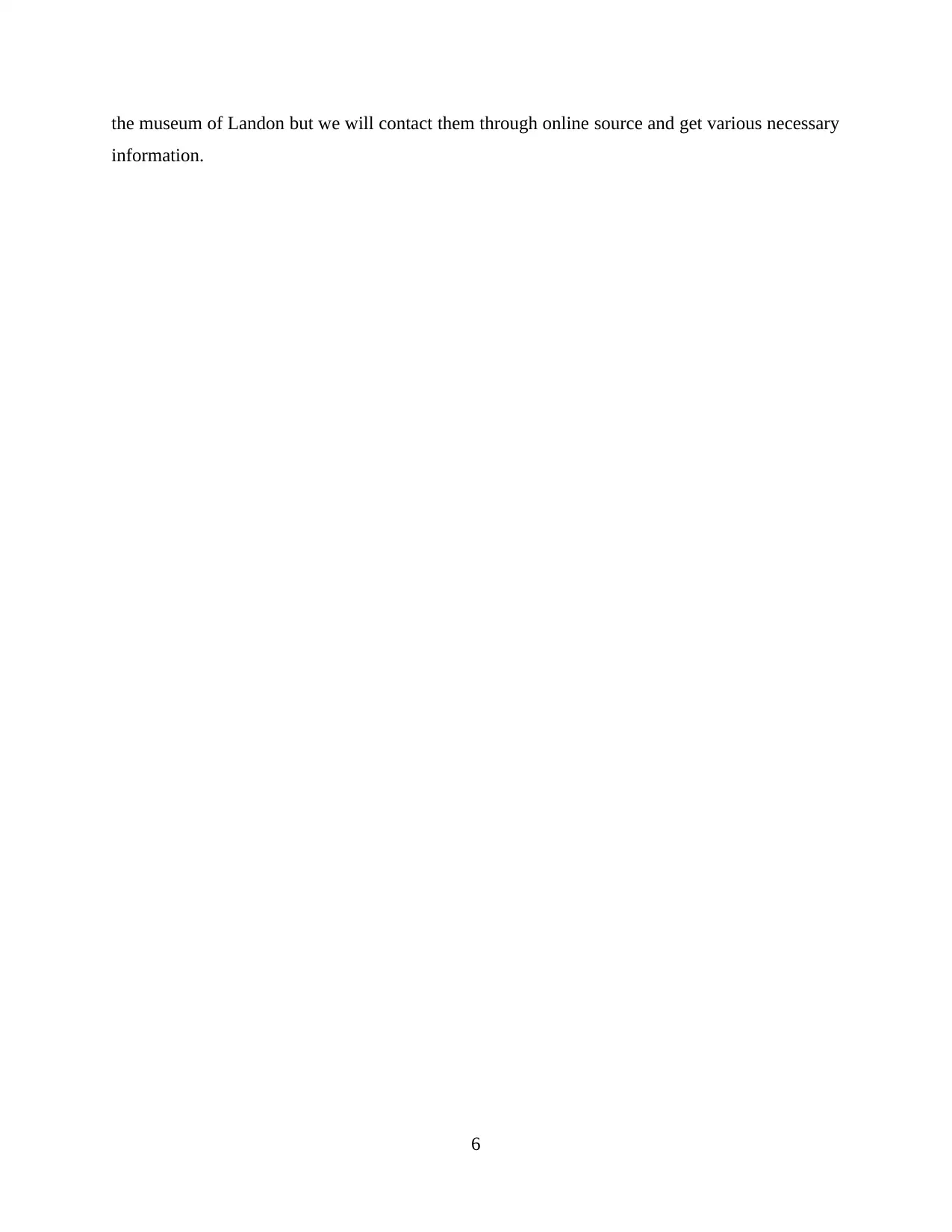
the museum of Landon but we will contact them through online source and get various necessary
information.
6
information.
6
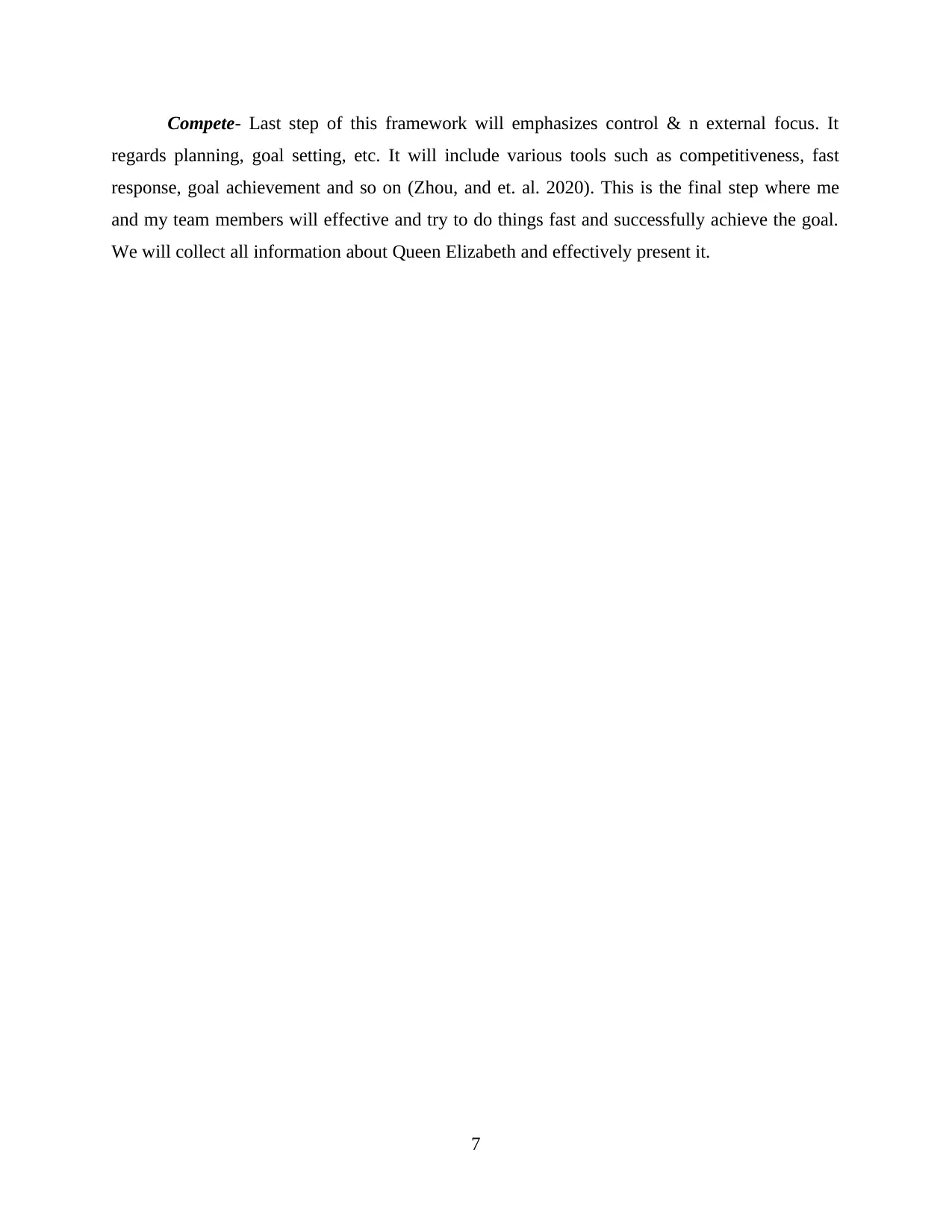
Compete- Last step of this framework will emphasizes control & n external focus. It
regards planning, goal setting, etc. It will include various tools such as competitiveness, fast
response, goal achievement and so on (Zhou, and et. al. 2020). This is the final step where me
and my team members will effective and try to do things fast and successfully achieve the goal.
We will collect all information about Queen Elizabeth and effectively present it.
7
regards planning, goal setting, etc. It will include various tools such as competitiveness, fast
response, goal achievement and so on (Zhou, and et. al. 2020). This is the final step where me
and my team members will effective and try to do things fast and successfully achieve the goal.
We will collect all information about Queen Elizabeth and effectively present it.
7
⊘ This is a preview!⊘
Do you want full access?
Subscribe today to unlock all pages.

Trusted by 1+ million students worldwide
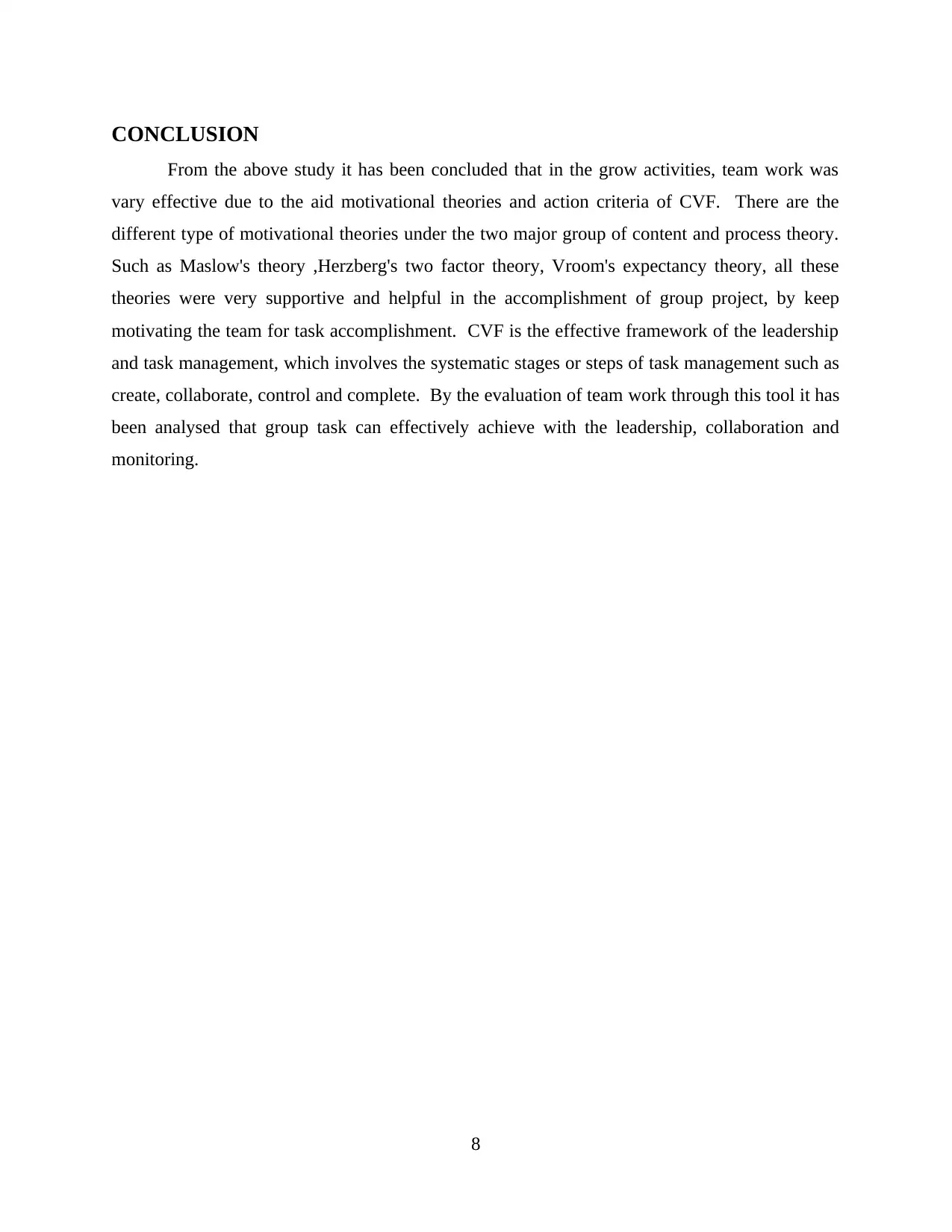
CONCLUSION
From the above study it has been concluded that in the grow activities, team work was
vary effective due to the aid motivational theories and action criteria of CVF. There are the
different type of motivational theories under the two major group of content and process theory.
Such as Maslow's theory ,Herzberg's two factor theory, Vroom's expectancy theory, all these
theories were very supportive and helpful in the accomplishment of group project, by keep
motivating the team for task accomplishment. CVF is the effective framework of the leadership
and task management, which involves the systematic stages or steps of task management such as
create, collaborate, control and complete. By the evaluation of team work through this tool it has
been analysed that group task can effectively achieve with the leadership, collaboration and
monitoring.
8
From the above study it has been concluded that in the grow activities, team work was
vary effective due to the aid motivational theories and action criteria of CVF. There are the
different type of motivational theories under the two major group of content and process theory.
Such as Maslow's theory ,Herzberg's two factor theory, Vroom's expectancy theory, all these
theories were very supportive and helpful in the accomplishment of group project, by keep
motivating the team for task accomplishment. CVF is the effective framework of the leadership
and task management, which involves the systematic stages or steps of task management such as
create, collaborate, control and complete. By the evaluation of team work through this tool it has
been analysed that group task can effectively achieve with the leadership, collaboration and
monitoring.
8
Paraphrase This Document
Need a fresh take? Get an instant paraphrase of this document with our AI Paraphraser

REFERENCES
Books and Journals
Chanda, A. and Mukherjee, A.K., 2020. Mass spectrometric analysis to unravel the venom
proteome composition of Indian snakes: opening new avenues in clinical research. Expert
Review of Proteomics. 17(5). pp.411-423.
Koppolu, S., 2018. Bioinformatic Applications to Understand the Responsiveness and
Regulation of Human Glycome (Doctoral dissertation, New York University).
Koshkin, A.P., and et. al. 2018. Role of social representations in student motivation for acquiring
further education. Interchange. 49(3). pp.313-341.
Morel, B., 2020. Prioritizing the Investments Needed to Avoid the Unmanageable (Mitigation)
and to Manage the Unavoidable (Adaptation). In Real Option Analysis and Climate
Change (pp. 95-115). Springer, Cham.
Oeldorf-Hirsch, A., 2018. The role of engagement in learning from active and incidental news
exposure on social media. Mass communication and society. 21(2). pp.225-247.
Prochaska, J.O. and Norcross, J.C., 2018. Systems of psychotherapy: A transtheoretical analysis.
Oxford University Press.
Rhodes, R.E., and et. al. 2021. Enacting physical activity intention: A multi-process action
control approach. In Motivation and Self-regulation in Sport and Exercise (pp. 8-19).
Routledge.
Richardson, P.W. and Watt, H.M., 2018. Teacher professional identity and career motivation: A
lifespan perspective. In Research on teacher identity (pp. 37-48). Springer, Cham.
Schwarz, N. and Bless, H., 2020. Happy and mindless, but sad and smart? The impact of
affective states on analytic reasoning. In Emotion and social judgments (pp. 55-71).
Garland Science.
Tahir, R., and et. al. 2021, May. Seeing is Believing: Exploring Perceptual Differences in
DeepFake Videos. In Proceedings of the 2021 CHI Conference on Human Factors in
Computing Systems (pp. 1-16).
Zhou, S., and et. al. 2020. Hierarchical U-shape attention network for salient object
detection. IEEE Transactions on Image Processing. 29. pp.8417-8428.
9
Books and Journals
Chanda, A. and Mukherjee, A.K., 2020. Mass spectrometric analysis to unravel the venom
proteome composition of Indian snakes: opening new avenues in clinical research. Expert
Review of Proteomics. 17(5). pp.411-423.
Koppolu, S., 2018. Bioinformatic Applications to Understand the Responsiveness and
Regulation of Human Glycome (Doctoral dissertation, New York University).
Koshkin, A.P., and et. al. 2018. Role of social representations in student motivation for acquiring
further education. Interchange. 49(3). pp.313-341.
Morel, B., 2020. Prioritizing the Investments Needed to Avoid the Unmanageable (Mitigation)
and to Manage the Unavoidable (Adaptation). In Real Option Analysis and Climate
Change (pp. 95-115). Springer, Cham.
Oeldorf-Hirsch, A., 2018. The role of engagement in learning from active and incidental news
exposure on social media. Mass communication and society. 21(2). pp.225-247.
Prochaska, J.O. and Norcross, J.C., 2018. Systems of psychotherapy: A transtheoretical analysis.
Oxford University Press.
Rhodes, R.E., and et. al. 2021. Enacting physical activity intention: A multi-process action
control approach. In Motivation and Self-regulation in Sport and Exercise (pp. 8-19).
Routledge.
Richardson, P.W. and Watt, H.M., 2018. Teacher professional identity and career motivation: A
lifespan perspective. In Research on teacher identity (pp. 37-48). Springer, Cham.
Schwarz, N. and Bless, H., 2020. Happy and mindless, but sad and smart? The impact of
affective states on analytic reasoning. In Emotion and social judgments (pp. 55-71).
Garland Science.
Tahir, R., and et. al. 2021, May. Seeing is Believing: Exploring Perceptual Differences in
DeepFake Videos. In Proceedings of the 2021 CHI Conference on Human Factors in
Computing Systems (pp. 1-16).
Zhou, S., and et. al. 2020. Hierarchical U-shape attention network for salient object
detection. IEEE Transactions on Image Processing. 29. pp.8417-8428.
9

10
⊘ This is a preview!⊘
Do you want full access?
Subscribe today to unlock all pages.

Trusted by 1+ million students worldwide
1 out of 13
Related Documents
Your All-in-One AI-Powered Toolkit for Academic Success.
+13062052269
info@desklib.com
Available 24*7 on WhatsApp / Email
![[object Object]](/_next/static/media/star-bottom.7253800d.svg)
Unlock your academic potential
Copyright © 2020–2025 A2Z Services. All Rights Reserved. Developed and managed by ZUCOL.





